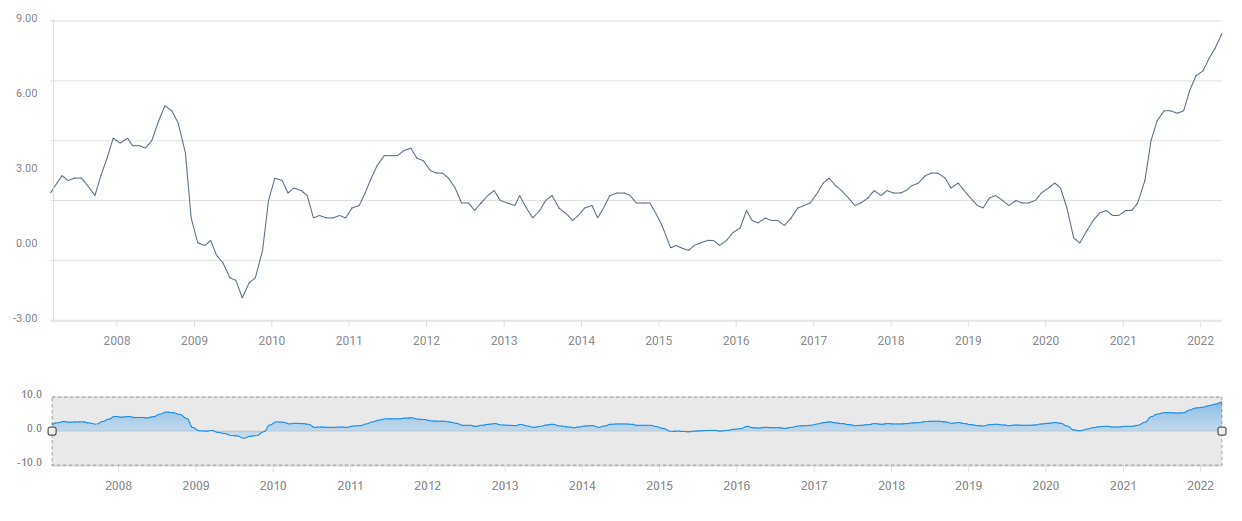- Annual CPI in the US is forecast to decline to 8.1% in April.
- Underlying factors driving inflation higher remain in place.
- A soft CPI print could cause the dollar to face temporary selling pressure.
Annual inflation in the US, as measured by the Consumer Price Index (CPI), climbed to its highest level in four decades at 8.5% in March. On a yearly basis, CPI is forecast to decline to 8.1% in April. Core CPI, which excludes volatile food and energy prices, is expected to fall to 6% from 6.5% in the same period.
US Consumer Price Index (YoY)
Has inflation peaked in the US?
The Prices Paid component of the ISM Manufacturing PMI declined to 84.6 in April from 87.1, showing that input prices in the manufacturing sector continued to rise at a softer pace than they did in March. On the other hand, the ISM Services PMI report revealed that the Prices Paid sub-index climbed to a new all-time high of 84. from 83.8. Moreover, crude oil prices rose more than 3% in April.
Just by looking at these figures, it’s difficult to conclude that the 8.5% CPI inflation recorded in March was the peak. Additionally, coronavirus-related restriction measures and lockdowns in China remained in place throughout the month, suggesting that supply-chain challenges are likely to continue to drive prices higher. In the meantime, consumer demand remains healthy in the US. The US Bureau of Economic Analysis’ latest publication revealed a 1.1% increase in consumer spending in March, compared to the market expectation of 0.7%.
The strong consumer demand combined with higher input and energy prices in the private sector indicates that inflationary pressures are likely to remain high in the next couple of months.
Assessing the S&P Global’s April PMI survey for the US, “many businesses continue to report a tailwind of pent up demand from the pandemic but companies are also facing mounting challenges from rising inflation and the cost of living squeeze, as well as persistent supply chain delays and labor constraints,” said Chris Williamson, Chief Business Economist at S&P Global.
Market implications
Even if CPI prints were to point to a slowdown in inflation in April, it will not be enough to convince investors that we are at the beginning of a downtrend. The protracted Russia-Ukraine conflict and its impact on crude oil prices, China’s zero-Covid policy and robust consumer activity all point to high inflation lasting for longer.
Nevertheless, the initial reaction to a soft CPI reading should cause the benchmark 10-year US Treasury bond yield to edge lower and force the greenback to weaken against its rivals with market participants reassessing how aggressively the Fed will continue to tighten its policy moving forward. Atlanta Fed President Raphael Bostic said on Monday that he is going to stay open to the possibility that inflation will be approaching policy target at a faster pace than projected. “If so, we would not need to do as much,” Bostic added. Similarly, Minneapolis Fed President Neel Kashkari told CNBC that he was on “team transitory” and noted that he was confident that the Fed could get inflation back down to the 2% target.
As mentioned above, however, factors that have been driving inflation higher remain in place and the Fed is unlikely to overreact to a single data point. Hence, a dollar sell-off on a weaker-than-expected CPI print should remain short-lived and provide an opportunity for investors to long the greenback at a lower cost.
On the flip side, a surprise increase in annual CPI should trigger another leg higher in the US Dollar Index and revive speculations about a 75 basis points rate hike in June. According to the CME Group FedWatch Tool, markets are pricing a 13.5% probability of such a move at the next policy meeting.
Information on these pages contains forward-looking statements that involve risks and uncertainties. Markets and instruments profiled on this page are for informational purposes only and should not in any way come across as a recommendation to buy or sell in these assets. You should do your own thorough research before making any investment decisions. FXStreet does not in any way guarantee that this information is free from mistakes, errors, or material misstatements. It also does not guarantee that this information is of a timely nature. Investing in Open Markets involves a great deal of risk, including the loss of all or a portion of your investment, as well as emotional distress. All risks, losses and costs associated with investing, including total loss of principal, are your responsibility. The views and opinions expressed in this article are those of the authors and do not necessarily reflect the official policy or position of FXStreet nor its advertisers. The author will not be held responsible for information that is found at the end of links posted on this page.
If not otherwise explicitly mentioned in the body of the article, at the time of writing, the author has no position in any stock mentioned in this article and no business relationship with any company mentioned. The author has not received compensation for writing this article, other than from FXStreet.
FXStreet and the author do not provide personalized recommendations. The author makes no representations as to the accuracy, completeness, or suitability of this information. FXStreet and the author will not be liable for any errors, omissions or any losses, injuries or damages arising from this information and its display or use. Errors and omissions excepted.
The author and FXStreet are not registered investment advisors and nothing in this article is intended to be investment advice.
Recommended Content
Editors’ Picks

EUR/USD recovers from two-year lows, stays below 1.0450
EUR/USD recovers modestly and trades above 1.0400 after setting a two-year low below 1.0350 following the disappointing PMI data from Germany and the Eurozone on Friday. Market focus shifts to November PMI data releases from the US.

GBP/USD falls to six-month lows below 1.2550, eyes on US PMI
GBP/USD extends its losses for the third successive session and trades at a fresh fix-month low below 1.2550 on Friday. Disappointing PMI data from the UK weigh on Pound Sterling as investors await US PMI data releases.

Gold price refreshes two-week high, looks to build on momentum beyond $2,700 mark
Gold price hits a fresh two-week top during the first half of the European session on Friday, with bulls now looking to build on the momentum further beyond the $2,700 mark. This marks the fifth successive day of a positive move and is fueled by the global flight to safety amid persistent geopolitical tensions stemming from the intensifying Russia-Ukraine war.

S&P Global PMIs set to signal US economy continued to expand in November
The S&P Global preliminary PMIs for November are likely to show little variation from the October final readings. Markets are undecided on whether the Federal Reserve will lower the policy rate again in December.

Eurozone PMI sounds the alarm about growth once more
The composite PMI dropped from 50 to 48.1, once more stressing growth concerns for the eurozone. Hard data has actually come in better than expected recently – so ahead of the December meeting, the ECB has to figure out whether this is the PMI crying wolf or whether it should take this signal seriously. We think it’s the latter.

Best Forex Brokers with Low Spreads
VERIFIED Low spreads are crucial for reducing trading costs. Explore top Forex brokers offering competitive spreads and high leverage. Compare options for EUR/USD, GBP/USD, USD/JPY, and Gold.
